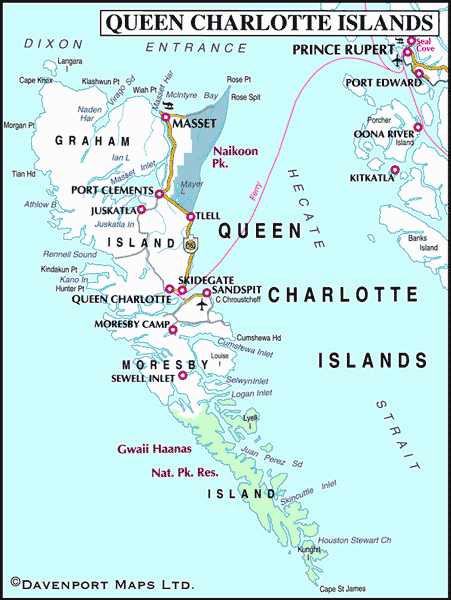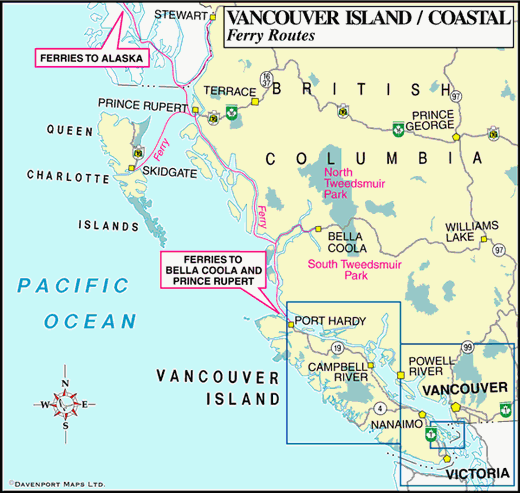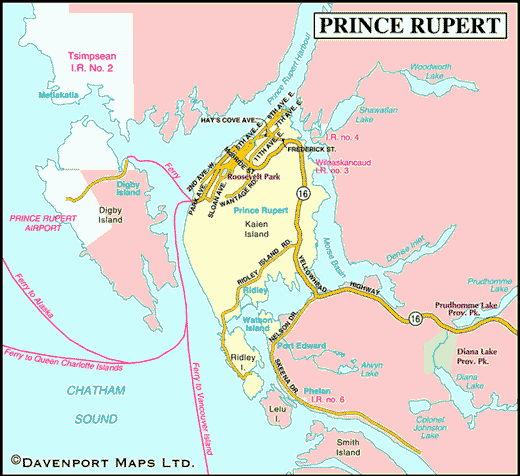Welcome to Northern British Columbia. This vast and wilderness region of British Columbia comprises of three geographical regions, the North West, the North East and Haida Gwaii, formerly called the Queen Charlotte Islands.
The Northwest
There are many things this area isn’t. It’s not home to a major city such as Vancouver or even Prince George; it’s not a hugely popular tourist destination such as the near-mythical Haida Gwaii (Queen Charlotte Islands) or the cozy Okanagan Valley are; and it doesn’t contain vast tracts of uncharted wilderness such as the north does.
Therefore, it’s easy to overlook or underappreciate what, on closer inspection, is an adventurer’s playground. Accessible by paved road, ferry, and plane, this region is filled with both unique wilderness experiences and the ‘standard’ British Columbia fare of deep fjords, dramatic canyons, sheer mountains, rivers thick with salmon, old-growth forests, and an abundance of wildlife.
Nestled up under the Alaska Panhandle, this is the province’s northernmost coast. It’s home to the Skeena, the second-largest river in British Columbia. Over five million salmon return to the Skeena every year, making this a premier salmon-fishing area. Prince Rupert, with its highway, rail, air, and ferry connections, serves as a gateway to pristine wilderness.
Stop and stay awhile on your way through – there’s room to relax and to play in this region, so rich in Native and pioneer history. And since this area includes the world’s largest intact coastal rain forest, bring your rain gear, just in case!
Like most Canadian provinces, British Columbia is bottom-heavy, with much of its population tucked away into its southwest corner. Vanderhoof, about 60 miles (100 km) west of Prince George on Highway 16, is the geographic centre of British Columbia, and yet is considered to be well ensconced in the northern half of the province. But then, for many people in the Lower Mainland, anything north of Whistler is the far north.
This is land steeped in history. Alexander Mackenzie walked this way in 1793, becoming the first European to cross North America by land. The Alexander Mackenzie Historical Trail weaves its way through the vast wilderness between Highways 16 and 20 to the south, and is one of the longest hiking trails in the province. Fort St. James, north of Vanderhoof, is one of the oldest white settlements in British Columbia. Every campground you visit, every trail you walk, every canoe route you travel likely has some history attached to it, from prehistoric fossils at Driftwood Canyon Provincial Park to century-old Native grease trails, to turn-of-the-century gold-rush and telegraph trails.
In the past, people had to walk, ride horses, or take canoes. Now, Highway 16 runs west from Prince George, carrying you through the north end of the Interior Plateau, a land rife with lakes of all sizes. Is it any wonder that this is fishing country, and that water sports are one of the most popular forms of summer recreation?
This is also a land of long, cold winters and short, hot summers. In winter, the temperature can drop to below -22 deg F/-30 deg C for weeks on end. In the summer, clouds of insects, most of them out for blood, swarm about in early evening. If you are planning on travelling in this area, know your enemies and come prepared.
[FAGP id=28232]
The Northeast
When people think of the Rocky Mountains, they usually think of Banff and Jasper National Parks on the Alberta side of the British Columbia-Alberta border. It doesn’t register that a major portion of these mountains spill across the Alberta border, cutting a vast swath across the northern half of British Columbia. The Rocky Mountains and their foothills dominate the Northeast, comprising roughly 20 million acres (8 million hectares). There are no roads that cross the range north of Pine Pass (between Mackenzie and Chetwynd) until the Yukon border. The Northern Rocky Mountains are the largest roadless landscape south of the 60th parallel, as well as one of the richest and most varied intact large wildlife ecosystems remaining in North America. The area’s wildlife population is so prolific that this portion of the Northern Rockies has been dubbed the Serengeti of North America.
In the vast, highwayless gulf between the Alaska Highway, which begins in Dawson Creek at Mile 0, and Hwy 37 to the west is an area that at its most expansive is 700 km wide and 1,200 km long. To put that in perspective, you could drop Switzerland into this region and not have road access. This is big country. Most people don’t venture more than a few miles off paved road. Some never make it off pavement at all, but if you do, a world of recreational opportunities awaits, whether you’re a weekend adventurer or a trail-hardened backpacker. People who go out unprepared into this wilderness, however, don’t come back. Ignorance and arrogance in the face of nature are the surest ways of getting yourself killed. Come prepared, and enjoy the rich and varied wilderness, a place where people are scarce, but the exploits plentiful.
Haida Gwaii (Queen Charlotte Islands)
They lie on the edge of the province’s collective memory like a dream scarce remembered; mythical and elusive, full of meaning and beauty, yet incomprehensible to the waking mind. Impossible not to marvel at, and revel in, this is Haida Gwaii, the former Queen Charlotte Islands, arguably one of the most beautiful and diverse landscapes in the world. Sometimes called Canada’s Galapagos, they form a distinctive ecosystem. The animals are familiar yet different. The black bears here, for instance, have a longer snout than elsewhere. They’re also bigger, flying in the face of the so-called island rule of evolution, that large animals get smaller when trapped on an island (a rule that was conceived, incidentally, by naturalist Bristol Foster while studying evolutionary patterns in Haida Gwaii).
The Haida Gwaii islands are about 100 km off the mainland, and are made up of about 150 islands. Two islands, Graham to the north and Morseby to the south, comprise the majority of the land mass. Most of Moresby is inaccessible by car except via logging road (a far, far too common feature of Haida Gwaii) or an alternative form of transportation, such as chartered boat, sea kayak, floatplane, or foot. Wildly undeveloped and unprotected, much of the land mass is open to resource-based exploitation.
The English name for these islands is prosaic, almost boring. Named for the wife of King George III, or rather, for the ship that was named for her, the name hardly serves to capture their elusive quality. The Haida name that the islands go by now is hardly better: Haida Gwaii, the place of the people. It’s a name that was given after the land was taken away from the Haida, and then part of it given back, grudgingly, after European diseases destroyed an entire culture and reduced the population of 30,000 Haida to a mere 600.
There is an older name for this place, a name that comes from the mists of time and seems to be the most appropriate name of all: Xhaaidlagha Gwaayaai, Islands at the Boundary of the World.
Location: As its name implies, this region of British Columbia is located in the northern part of the province, between the Yukon and Northwest Territories in the Canadian North, and the Cariboo and Chilcotin in the interior of BC. The Northern BC tourism region also includes Haida Gwaii, formerly the Queen Charlotte Islands, located off the west coast of BC. Access into the remote north is via the three highways; The Alaska Highway 97 in the east, the Stewart-Cassiar Hwy 37 in the west, and Yellowhead Highway 16 in the southern portion of this region.
Click for detailed information on the Towns and Communities of Northern British Columbia.




